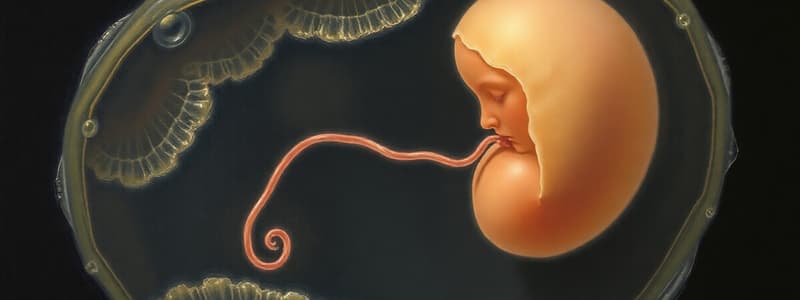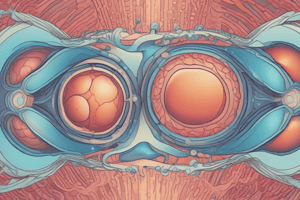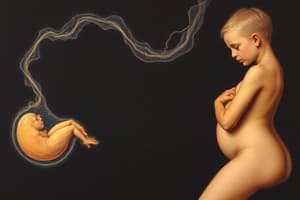Podcast
Questions and Answers
What is the primary characteristic of mosaic development in embryos?
What is the primary characteristic of mosaic development in embryos?
In regulated specification, what primarily determines blastomere fates?
In regulated specification, what primarily determines blastomere fates?
What happens if blastomeres separate into two groups in species with regulative development?
What happens if blastomeres separate into two groups in species with regulative development?
Which germ layer is responsible for forming structures such as the nervous system and skin?
Which germ layer is responsible for forming structures such as the nervous system and skin?
Signup and view all the answers
What is the function of the archenteron during gastrulation?
What is the function of the archenteron during gastrulation?
Signup and view all the answers
What layer forms the lining of the digestive and respiratory tracts?
What layer forms the lining of the digestive and respiratory tracts?
Signup and view all the answers
In humans, what is a consequence of being able to remove a blastomere without harming the embryo?
In humans, what is a consequence of being able to remove a blastomere without harming the embryo?
Signup and view all the answers
What structure results from the invagination of the vegetal pole during gastrulation?
What structure results from the invagination of the vegetal pole during gastrulation?
Signup and view all the answers
What role does the gray crescent play during development?
What role does the gray crescent play during development?
Signup and view all the answers
What initiates the cytoplasmic reorganization after fertilization?
What initiates the cytoplasmic reorganization after fertilization?
Signup and view all the answers
What is the role of bottle cells during amphibian gastrulation?
What is the role of bottle cells during amphibian gastrulation?
Signup and view all the answers
What is the significance of the gray crescent in amphibian development?
What is the significance of the gray crescent in amphibian development?
Signup and view all the answers
During which stage does the embryo become a solid ball of small cells?
During which stage does the embryo become a solid ball of small cells?
Signup and view all the answers
What is characteristic of complete cleavage?
What is characteristic of complete cleavage?
Signup and view all the answers
How do the organizer cells influence embryonic development?
How do the organizer cells influence embryonic development?
Signup and view all the answers
What occurs during discoidal cleavage?
What occurs during discoidal cleavage?
Signup and view all the answers
Which germ layer is directly responsible for the initiation of the nervous system?
Which germ layer is directly responsible for the initiation of the nervous system?
Signup and view all the answers
What process occurs when cells elongate and intercalate during gastrulation?
What process occurs when cells elongate and intercalate during gastrulation?
Signup and view all the answers
What results from the interaction between GSK-3 and β-catenin?
What results from the interaction between GSK-3 and β-catenin?
Signup and view all the answers
In superficial cleavage, what happens to the plasma membrane?
In superficial cleavage, what happens to the plasma membrane?
Signup and view all the answers
In relation to anterior–posterior axis development, what role do organizer cells play?
In relation to anterior–posterior axis development, what role do organizer cells play?
Signup and view all the answers
What is a major outcome of cytoplasmic movement after fertilization?
What is a major outcome of cytoplasmic movement after fertilization?
Signup and view all the answers
What is formed when cells pass over the dorsal lip on the midline during gastrulation?
What is formed when cells pass over the dorsal lip on the midline during gastrulation?
Signup and view all the answers
What is the primary outcome of gastrulation in embryonic development?
What is the primary outcome of gastrulation in embryonic development?
Signup and view all the answers
What is the primary role of extraembryonic membranes in vertebrates?
What is the primary role of extraembryonic membranes in vertebrates?
Signup and view all the answers
Which of the following membranes is responsible for protecting the embryo by forming a fluid-filled cavity?
Which of the following membranes is responsible for protecting the embryo by forming a fluid-filled cavity?
Signup and view all the answers
Which extraembryonic membrane is involved in waste storage?
Which extraembryonic membrane is involved in waste storage?
Signup and view all the answers
In placental mammals, which structure is primarily responsible for facilitating the contact with maternal blood?
In placental mammals, which structure is primarily responsible for facilitating the contact with maternal blood?
Signup and view all the answers
How are Hox genes arranged in relation to their function in the embryo?
How are Hox genes arranged in relation to their function in the embryo?
Signup and view all the answers
What is formed from the hypoblast cells in early mammalian development?
What is formed from the hypoblast cells in early mammalian development?
Signup and view all the answers
Which of the following is NOT a function of the chorion?
Which of the following is NOT a function of the chorion?
Signup and view all the answers
What is the purpose of the trophoblast's adhesion molecules?
What is the purpose of the trophoblast's adhesion molecules?
Signup and view all the answers
What is the primary function of the placenta during pregnancy?
What is the primary function of the placenta during pregnancy?
Signup and view all the answers
What does the amnion produce and what is its significance during pregnancy?
What does the amnion produce and what is its significance during pregnancy?
Signup and view all the answers
What role do blood vessels in the umbilical cord play during fetal development?
What role do blood vessels in the umbilical cord play during fetal development?
Signup and view all the answers
During which trimester of pregnancy does the heart begin to beat?
During which trimester of pregnancy does the heart begin to beat?
Signup and view all the answers
What major developmental milestones occur during the first trimester?
What major developmental milestones occur during the first trimester?
Signup and view all the answers
What is the duration of a typical human gestation period?
What is the duration of a typical human gestation period?
Signup and view all the answers
Which trimester sees significant elongation of limbs and development of the nervous system?
Which trimester sees significant elongation of limbs and development of the nervous system?
Signup and view all the answers
Why is the first trimester considered the most critical period for fetal development?
Why is the first trimester considered the most critical period for fetal development?
Signup and view all the answers
Study Notes
Fertilization Activates Development
- The sperm enters the animal hemisphere of the egg.
- The cortical (outer) cytoplasm rotates toward the site of sperm entry.
- The gray crescent forms opposite the site of sperm entry.
- The gray crescent specifies body axes and other developmental events.
- The centriole from the sperm initiates cytoplasmic reorganization.
- Microtubules in the vegetal hemisphere form a parallel array to guide movement of cytoplasm and organelles.
- Cytoplasmic movement changes the distributions of critical developmental signals.
- The protein kinase GSK-3, an inhibitor of GSK-3, and the protein β-catenin interact, resulting in a higher concentration of b-catenin on the dorsal side.
- The higher concentration of b-catenin on the dorsal side specifies the dorsal–ventral axis of the embryo.
Mitosis Divides Up the Early Embryo
- Cleavage: early cell divisions with no cell growth.
- The embryo becomes a solid ball of small cells.
- Blastocoel: a central fluid-filled cavity that forms in the ball.
- The embryo becomes a blastula and its cells are called blastomeres.
- The pattern of cleavage varies with species.
- Complete cleavage occurs in eggs with little yolk; the blastomeres are similar in size.
- In frogs, the vegetal pole has more yolk; division is unequal, and daughter cells in the animal pole are smaller.
- Incomplete cleavage occurs in eggs with a lot of yolk when cleavage furrows don’t penetrate the egg completely.
- In discoidal cleavage, the embryo forms as a blastodisc that sits on top of the yolk.
- Superficial cleavage is a variation of incomplete cleavage in insects. The plasma membrane grows inward around nuclei and forms cells.
- Blastomeres become determined - committed to specific fates - at different times in different species.
- In mosaic development, each blastomere contributes certain aspects to the adult animal (autonomous specification).
- If one blastomere is removed, a portion of the embryo will not form.
- Regulated specification: in most vertebrates, blastomere fate is determined by information from the environment and neighboring cells.
- Regulative development: other cells compensate for any lost cells.
- In humans, one blastomere can be removed for genetic analysis without harming the embryo.
- In species with regulative development, if blastomeres separate into two groups, each can become an embryo.
- Monozygotic twins come from the same zygote and are identical.
- Non-identical twins develop from two eggs fertilized by two sperm.
Gastrulation Generates Multiple Tissue Layers
- Gastrulation: massive movements of cells transform the blastula into an embryo with multiple tissue layers and distinct body axes.
- In triplobastic animals, three germ layers (tissue layers) form.
- Endoderm layer: becomes lining of digestive and respiratory tracts, pancreas, thyroid, and liver.
- Ectoderm: outer layer; becomes the nervous system, eyes, ears, and skin.
- Mesoderm: middle layer; contributes tissues to many organs, including heart, blood vessels, muscles, and bone.
- In sea urchins, gastrulation begins with invagination.
- Archenteron cells extend, flatten, interdigitate, and migrate over one another to form a long thin tube (convergent extension).
- The mouth forms where the archenteron meets the ectoderm.
- The blastopore is the opening formed by invagination of the vegetal pole, and becomes the anus.
- Amphibian gastrulation: Bottle cells in the gray crescent bulge inward and form the dorsal lip.
- Cells move over the lip and into the blastocoel— involution.
- Convergent extension occurs when cells elongate as they move, and intercalate (move in between each other).
- Hans Spemann experimented with bisecting fertilized salamander eggs. Results differed depending on how the eggs were bisected.
- Spemann found that cytoplasmic factors, such as those in the gray crescent, are necessary for normal development.
- The organizer (dorsal lip) induces the beginnings of the body plan.
- The organizer changes its activity in order to induce different structures.
- The first organizer cells to enter the embryo become head endoderm and head mesoderm.
- Later cells induce structures of the trunk; the last cells induce tail structures.
- Organizer cells express appropriate growth factor antagonists at the right times to achieve different patterns of differentiation on the anterior–posterior axis.
Organs Develop from the Three Germ Layers
- Gastrulation produces an embryo with three germ layers that influence one another through inductive tissue interactions.
- Organogenesis: organs and organ systems develop.
- Neurulation: initiation of the nervous system— occurs early in organogenesis.
- One group of cells that passes over the dorsal lip on the midline becomes chordamesoderm.
- The notochord forms from the chordamesoderm.
- The notochord induces the overlying ectoderm to form the neural plate.
- The neural plate folds, forming the neural tube.
- The neural tube will become the brain and spinal cord.
- Hox genes are expressed along the anterior–posterior axis of the embryo in the same order as their arrangement on the chromosome.
- Different segments of the embryo receive different combinations of Hox gene products, which act as transcription factors.
Extraembryonic Membranes Nurture Avian and Mammalian Embryos
- Extraembryonic membranes surround the vertebrate embryo.
- Extraembryonic membranes function in nutrition, gas exchange, and waste removal.
- In mammals, they interact with the mother’s tissues to form the placenta.
- In the chick embryo, four membranes form:
- Yolk sac: encloses yolk within the egg.
- Yolk is digested by cells of the yolk sac and the nutrients are transported to the embryo.
- Allantoic membrane: forms the allantois, a sac for waste storage.
- Amnion: surrounds the embryo, forming the fluid-filled amniotic cavity that protects the embryo.
- Chorion: forms a continuous membrane just under the eggshell; reduces water loss and exchanges gases.
- In placental mammals, the trophoblast is the first extraembryonic membrane.
- Trophoblast cells interact with the endometrium; adhesion molecules attach them to the uterine wall.
- The trophoblast burrows into the uterine wall, and sends out villi to increase contact with maternal blood.
- Hypoblast cells form the chorion.
- The placenta develops from the chorion and uterine tissues.
- The placenta exchanges nutrients, gases, and wastes between mother and embryo.
- The epiblast produces the amnion, which surrounds the embryo and is filled with amniotic fluid.
- Rupturing of the amnion and chorion and loss of the amniotic fluid (the “water breaks”) herald the onset of labor in humans.
- Allantoic tissues contribute to formation of the umbilical cord, by which the embryo is attached to the chorionic placenta.
- Blood vessels in the umbilical cord carry nutrients and oxygen from the mother to the developing fetus, and carry away wastes, including CO2 and urea.
- Gestation, or pregnancy, in humans is about 266 days (9 months) and is divided into trimesters.
- In the first trimester, the embryo becomes a fetus:
- Heart begins to beat by week four.
- Limbs form by week eight.
- The first trimester is a time of rapid cell division and tissue differentiation.
- This is when the fetus is most susceptible to damage from radiation, drugs, chemicals, and pathogens that cause birth defects.
- Embryos can be damaged before the mother even realizes she is pregnant.
- Second trimester: limbs elongate; fingers, toes, and facial features form; nervous system develops.
- Third trimester: internal organs mature.
- Birth occurs when the lungs are mature.
- The potential for serious effects from exposure to environmental factors exists throughout pregnancy.
Studying That Suits You
Use AI to generate personalized quizzes and flashcards to suit your learning preferences.
Related Documents
Description
This quiz covers the essential processes of fertilization and early mitosis in embryology. It outlines the steps from sperm entry to the early cleavage stages of the embryo, highlighting key events such as cytoplasmic movement and the formation of body axes. Test your knowledge on these crucial developmental stages.





